One of the big stories of today is that AMD plans to acquire Pensando for roughly $1.9B. That is a lot of money. With this acquisition, AMD is formally entering the DPU and infrastructure fray, and frankly, it needed to. Since we have been covering the DPU space heavily, discussing solutions, defining the DPU space, and soon (next 2-3 weeks) we will have tangible examples of using DPUs that we are going to showcase, I wanted to give a bit of context for today’s deal and what it means for AMD and the rest of the industry.
Video Version
We also have a quick video version of this article that was super quick so that it could hit the release time this morning:
As always, we suggest opening this in its own YouTube window, tab, or app for the best viewing results. If you want to read, of course, we have a version of that as well below.
What is a DPU anyway?
We use the “DPU” term to categorize the Pensando product. It is certainly a far step above the SmartNIC category and also not what we would call an “Exotic” solution with a FPGA (AMD now has Xilinx for that.) We have a STH NIC Continuum framework to help explain different NIC categories:
Also, in our “What is a DPU?” piece, we go into some of Pensando’s products, along with some others in the industry.
Since we did that piece, Fungible has changed its strategy a bit. Intel now has its IPU’s that encompass some exotic and DPU options, and NVIDIA has discussed BlueField-3 a bit more. Still, for Pensando’s current products, this is a good snapshot in time of the available solutions. It will also help explain some of the market contexts around the acquisition.
What is Pensando?
Pensando’s physical products are called its “Distributed Services Card”. This card basically marries a high-speed network interface, with a P4 programmable pipeline engine, an Arm CPU complex, memory controllers, accelerators for cryptography, storage, and more, and also PCIe Gen4. All of these features go onto a PCIe card.

These days, the market is focused more on the company’s 7nm (TSMC) “Elba” card, and the previous generation is called “Capri”. We will quickly note here that a competitive product in this class will likely need to be PCIe Gen5 later this year, and we are almost two years from the prototypes of Elba, and there is an almost two-year cadence between product cycles.
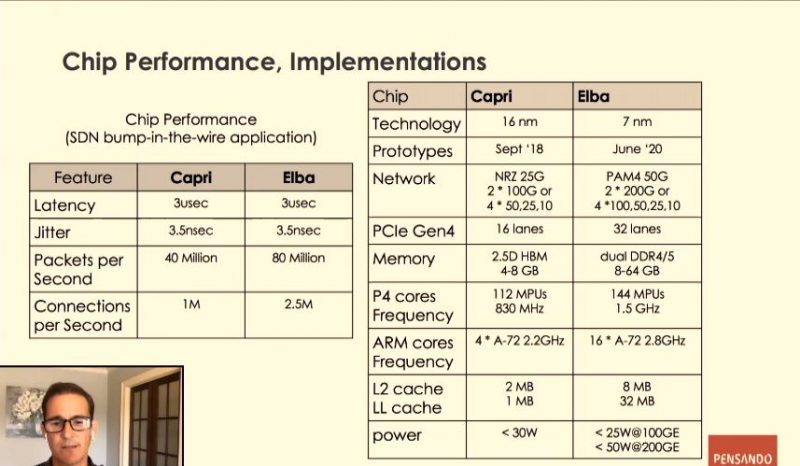
Here is the floorplans, but please note that the 16nm parts have larger gates so the 7nm part is effectively enlarged to show a similar scale.
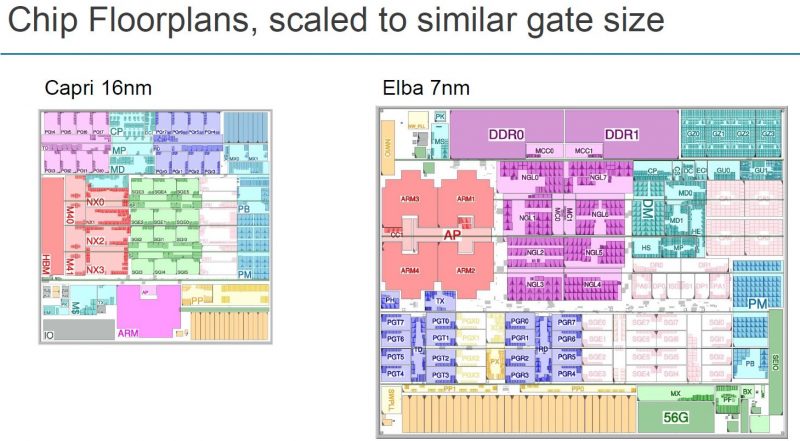
Here was the Capri block diagram:
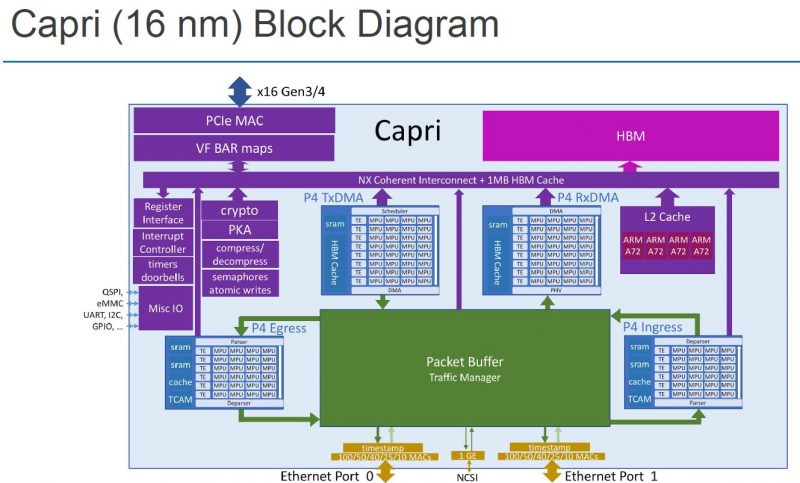
With Elba, we can see that HBM was traded for lower-cost DDR4 and DDR5. The P4 engines, accelerators, and more were all increased with a better NOC.
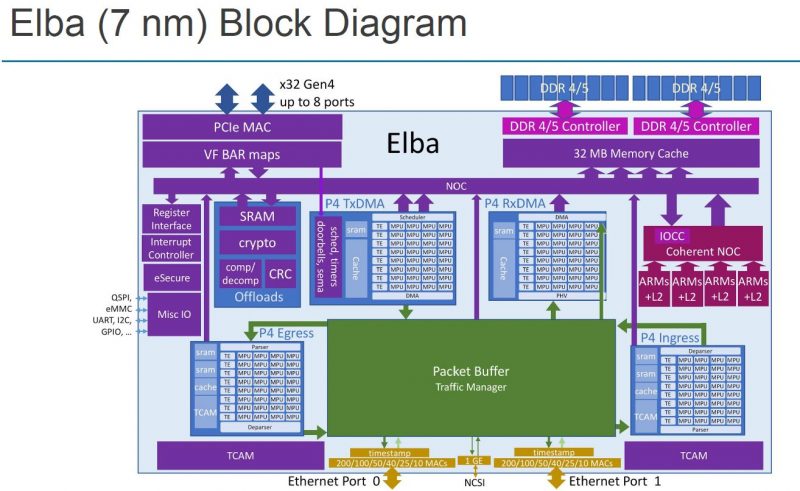
The key here is that the way Pensando’s solution works is by managing traffic more similarly to how it would be managed in a switch in a P4 pipeline. Customers or software providers can utilize the pipeline and then build additional acceleration on certain parts of the pipeline.
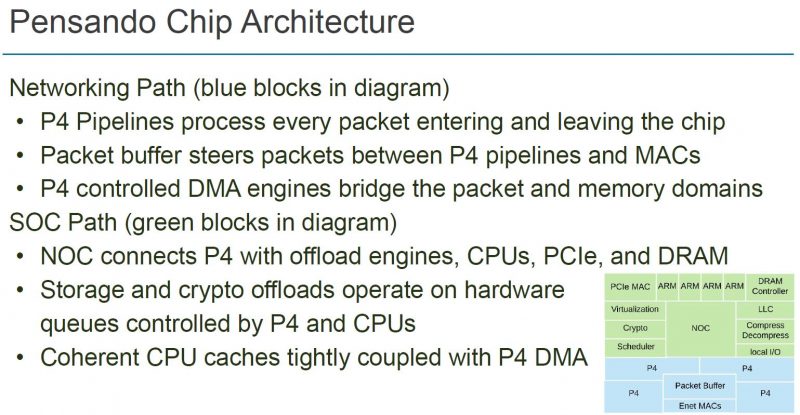
While some may see Arm cores and immediately compare them to Intel Mount Evans, NVIDIA BlueField-2 (and newer) DPUs, Marvell Octeon 10 DPUs, in Pensando’s architecture, the main point is the P4 pipeline, not the Arm cores. If P4 sounds familiar in the DPU world, Intel has a number of IPUs, and the Mt. Evans product that is really focused on Google’s cloud at the moment features a P4-based toolchain.
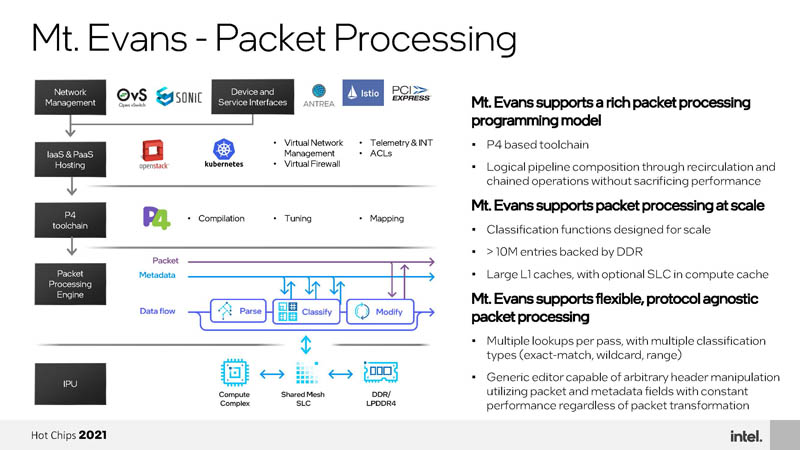
The more lone DPU maker now is Fungible. Fungible is using MIPS instead of Arm and was also born from an ex-switch/ router maker team.
One way to think about Pensando is that it can use its card as a point of trust for an infrastructure provider, whether cloud or an enterprise (Goldman Sachs is the lead reference customer on the enterprise side), and provide secure endpoints. These secure endpoints can handle a lot of the network logic folks have tried to build into switches, and then also provide services directly to the connected machines. For example, like AWS Nitro, it can provision storage and provide virtual machines and physical machines network connectivity. With the pipeline and crypto offloads, it can do more, such as ensuring that traffic in and out of the machine is encrypted. Think of this as a virtual private cloud with secure networking. Instead of having to do the crypto functions on the CPU, using valuable CPU cores, that can be offloaded to the DPU.
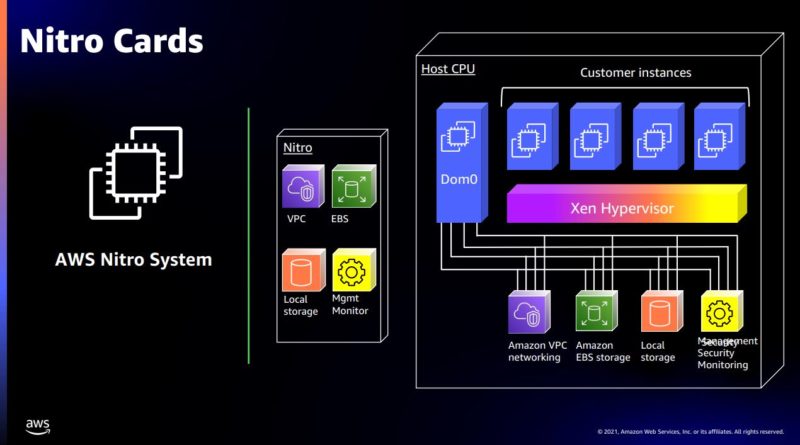
Pensando has been investing in a software stack and APIs to basically re-create a lot of what Nitro does for AWS. Pensando then lets customers choose what it wants to use. For example, NetApp ships some systems with Pensando DPUs, and those systems are using the cards just for the accelerator offloads and networking.
Why AMD is Buying Pensando
The next question is, why Pensando, not someone else? To me, there are basically two DPU startups left that seem to have some scale that it would make sense for AMD. Pensando is one, Fungible is the other. While Pensando is using P4 and Arm to build something “AWS Nitro-like”, Fungible started with a storage product. We did a hands-on with Fungible at its first launch.
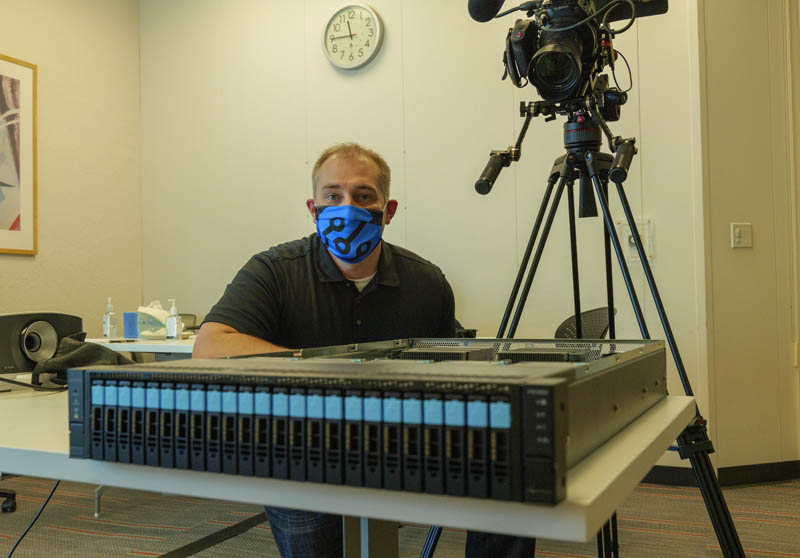
The strange part about this is that I was formally briefed on the AMD-Pensando deal yesterday, but last week I was telling the Fungible folks, as part of its announcement today, that they need to not just focus on a broader set of provisioning hardware for composability. My reasoning is that it needed to show different GPUs and accelerators in addition to storage to become more attractive to someone like AMD to purchase. A few days later, I was briefed on the AMD deal with Pensando.
Leading AMD’s data center and embedded products is Forrest Norrod. I have known Forrest for a few years now, as we have been covering that group’s products quite extensively since 2017 or so. Forrest is very methodical. They built CPUs with EPYC. AMD’s data center GPUs are now its “Instinct” line and those have their own branding and CDNA architecture versus RDNA for more graphics-focused GPUs. The MI250X is really a HPC accelerator at this point. Xilinx is for certain classes of devices and IP blocks (think chiplets with UCIe) for the data center and the embedded market. AMD needs AI acceleration hardware as it is trailing NVIDIA and Intel in that category. It also needed a DPU to bolster networking since Intel and NVIDIA are both actively pushing that line. Xilinx perhaps could have been the answer, but in the end, it was faster to purchase Pensando and de-risk getting a product by buying the best available independent DPU maker out there.
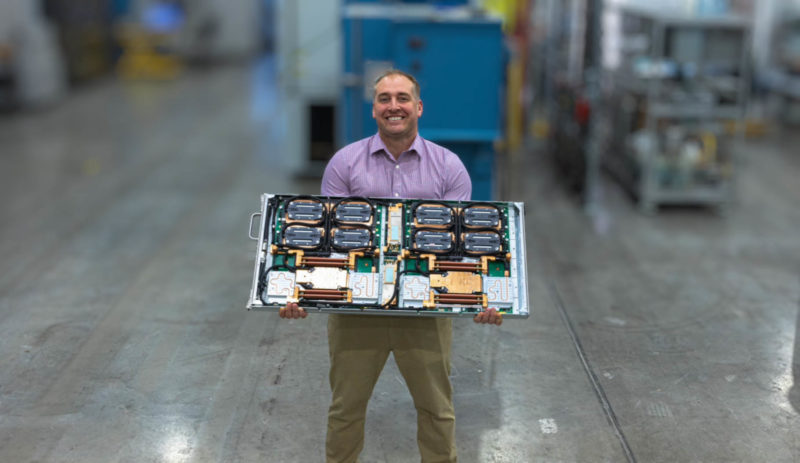
The AMD-Xilinx deal taking so long probably made it so that the Xilinx/ SolarFlare IP was probably not going to be the right option, and so AMD needed a solution and Pensando is the company that probably had the best fit.
AMD also needs to create a network products group at this point to drive that line. Whoever gets that job is probably going to wake up excited every morning since they will have Pensando plus Xilinx IP to pull from.
Final Words
Is $1.9B too much for Pensando? Given sky-high valuations in the industry, I do not think it is. One could argue that Intel, NVIDIA, and Marvell all have DPU options. Broadcom did, but the Stingray line seems to be languishing. Between Fungible which was initially, more storage focused and Pensando which was more focused on creating an AWS Nitro-like device, I think the right option for AMD was Pensando.
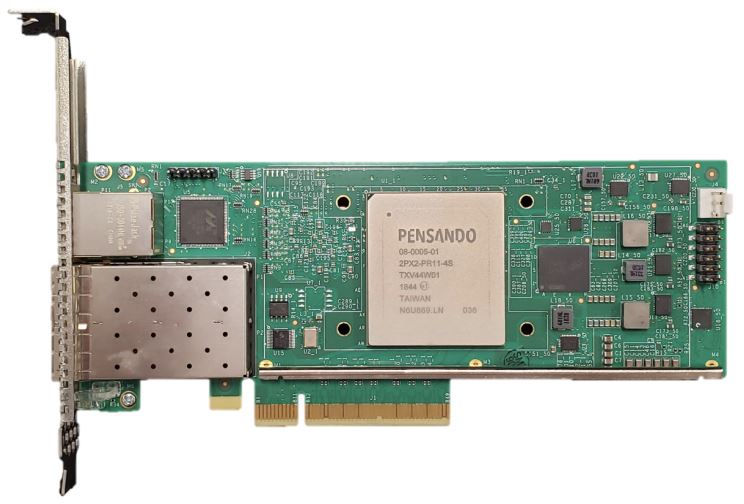
I think the road ahead for Fungible gets harder. It is the only MIPS-based solution while Intel is Arm/ x86 and the others are Arm. It is also the only company that does not have other hardware that it can bundle for data center buys.
I think congratulations to the Pensando team are in order. The data center space is getting very fun with many companies building larger solution stacks, and AMD’s just grew with this acquisition.
Also, I will just quickly plug that you are going to start seeing some of the DPU/ IPU content we have been working on over the past few months start to come out in the next 2-3 weeks. The AIC JBOX Review where we had a number of NVIDIA BlueField-2 DPUs was the real precursor to that series.

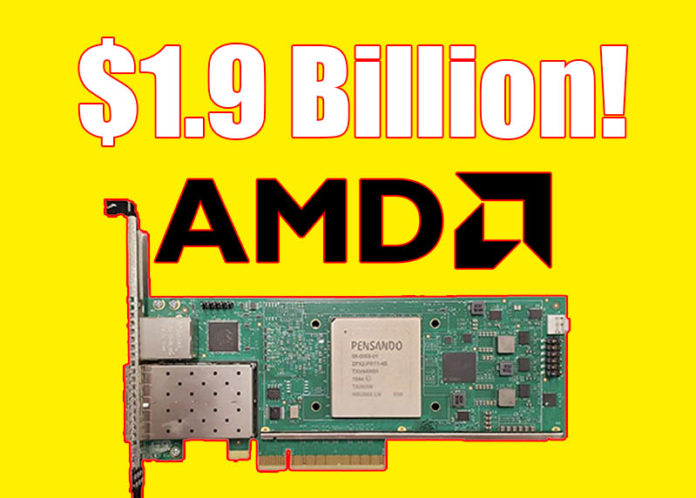
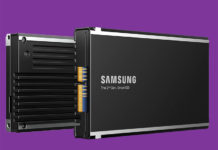


Portuguese-speaking person here. Do you know what “Pensando” means? It means “Thinking” in portuguese and in spanish. E.g. “Eu estou pensando” = “I’m thinking”.
I’m pretty sure that, in this case, “pensando” is italian as Elba and Capri are two italian islands.
The meaning is the same as portuguese and spanish, “thinking”.
Greetings from Italy
Maybe AMD needs this stuff for slingshot, some problems with the network are reported from the exascale computer.